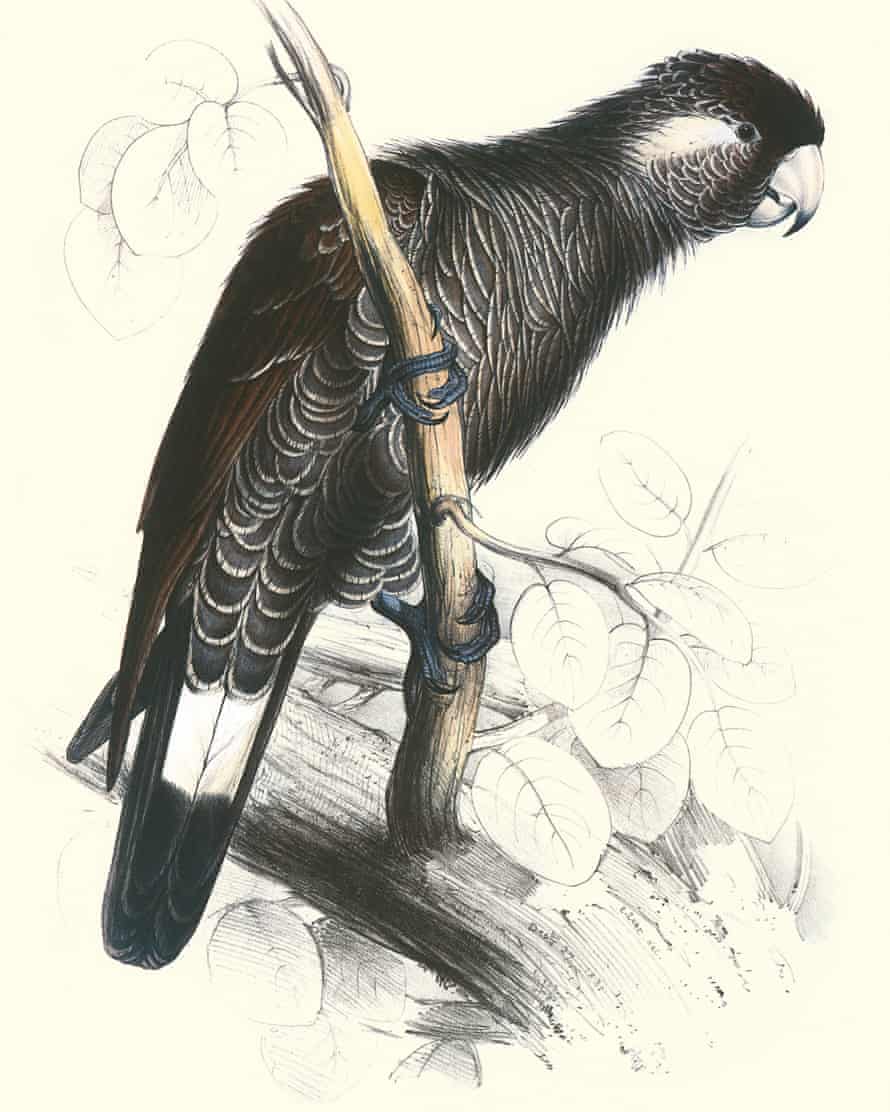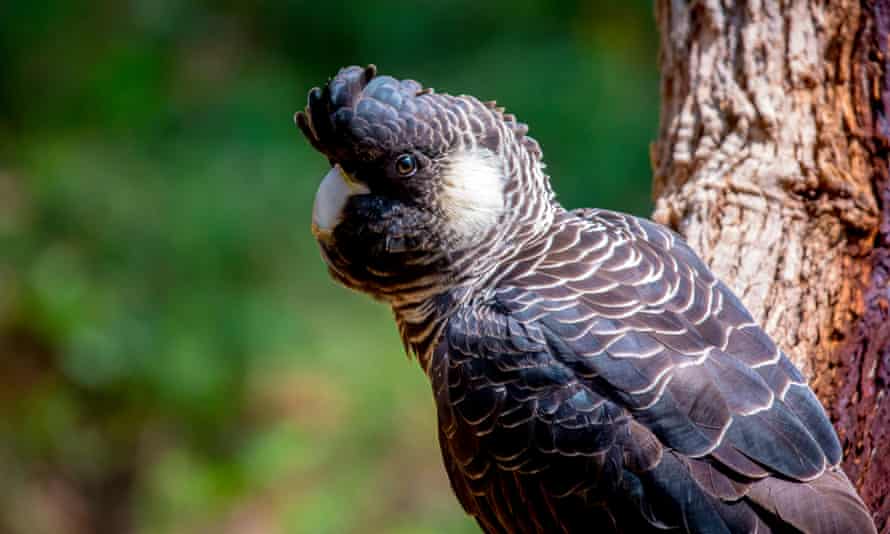‘I don’t think many people know they exist’: how mistaken identity threatens the Baudin’s cockatoo
The black cockatoo is nearly identical to its neighbour, the Carnaby’s. And that’s a problem for protecting the endangered species
- The Guardian/BirdLife Australia Bird of the Year poll for 2021 will begin on 27 September

In the early 1830s, the painter Edward Lear was painstakingly illustrating a black cockatoo, based on a specimen collected by French explorer Nicholas Baudin in the south-west of Western Australia in 1804.
The image, which would become the holotype for the Baudin’s cockatoo, was published in Illustrations of the Family of Psittacidae, or Parrots (1832). Back in Lear’s time it was believed that the Baudin’s was the only species of white-tailed black cockatoo. Another white-tailed black cockatoo, called the Carnaby’s, was classified as a subspecies. But more than a century later, scientists began to believe the differences between the two birds were far too significant for them to be considered one species; they breed differently, don’t eat the same food and occupy different habitats. The Carnaby’s was declared a separate species in 1979.

Decades later, Australian ornithologists scrutinised Lear’s bird paintings and noticed the painter had a tendency to exaggerate beak size. Physically, the one key difference between a Baudin’s and Carnaby’s is its beak: a Baudin’s cockatoo has a long, thin beak in comparison with the Carnaby’s stubby beak. The ornithologists wondered, could the specimen Lear painted and named the Baudin’s been a Carnaby’s the entire time?
When the original specimen Lear painted was located, in a collection stowed away in Liverpool in the UK, their suspicions were confirmed: the holotype we’d been referring to for Baudin’s cockatoos was actually painted from a short-billed Carnaby’s cockatoo specimen.
This may seem significant only to taxonomists, but the mix-up is critical to understanding the challenges facing the Baudin’s today. That we struggle to tell the difference between the two species of white-tailed cockatoo means the much less common Baudin’s could go extinct without most of us even noticing.
The Baudin’s is by far the least-known of the three black cockatoo species in WA. Carnaby’s can often be found soaring through the urban landscapes of Perth which means people are far more familiar with it, despite low populations. On the other hand, the forest-dwelling Baudin’s prefer the protection of a high roost, which makes them a difficult research subject.
“They’re less visible, there’s a lot less research on them in comparison to the Carnaby’s and they are much less known, so I think they’re a bit forgotten,” says Adam Peck, black cockatoo project coordinator at Birdlife Australia.
The annual Great Cocky Count, a long-term citizen science survey, can barely get a grasp of their population. “We don’t have as much of an idea about population trends [for the Baudin’s] because it’s actually very hard to tell Carnaby’s and Baudin’s apart. A lot of our surveyors record them as white-tail black cockies,” rather than specifying, Peck says.
The Great Cocky Count was first coordinated by Western Australian Museum black cockatoo expert Ron Johnstone back in 2010. Johnstone, unlike most people, knows the Baudin’s well enough to identify them without even looking at them. He says Baudin’s are surgeons with Marri and Karri nuts and leave very little waste, their calls differ from a Carnaby’s and they’re selective about their roosts, which have to be old.

“We’ve seen big drop-offs at traditional roost sites that we’ve been monitoring for 25 years. We’d get between 900 and 1,200 birds at some of these roosts in Wongong Valley [in the past]. Now, we’re getting 20-30, and that information helped us upgrade their conservation status from vulnerable to endangered in 2018.” According to BirdLife figures, this specific population has declined 10% each year.
Johnstone is a member of the national recovery team for all three species of south-west WA’s black cockatoos. The combined recovery plan for the Baudin’s, Carnaby’s and the forest red-tail was created in 2008 and set a 10-year goal of stabilising or increasing Baudin’s populations. In his role, Johnstone and other members of the recovery team have created educational resources for orchardists, discussed the impact of land clearing with the department and closely monitored the Baudin’s decline. Johnstone says it’s hard to say whether the recovery plan is working and that the government works “agonisingly” slowly.
“You see less and less Baudin’s now. Even if you go into a state forest where there were large flocks, you don’t see them anymore,” says Glenn Dewhurst, founder of Kaarakin, the only dedicated rehabilitation centre for Western Australia’s black cockatoos.
“As long as people see white-tailed cockatoos they don’t care if the Baudin’s go, which is sad. The mentality is to just protect Carnaby’s.”
Kaarakin education officer Sam Clarke took to social media in April to express his concerns for the Baudin’s. Clarke has worked closely with Baudin’s Princess Rex, an education bird at Kaarakin that came into the centre after a car strike. “People assume she’s a Carnaby’s. Very few people ever come and ask if she’s a Baudin’s … now that I think about it no one has.
“I don’t think many people know they exist, and I think that’s one of the biggest injustices, which is why Rex is so important.”
Kaarakin is of the view that shooting by orchardists is the biggest problem. Up until the 1960s, Baudin’s had a bounty on their heads and despite the fact that their populations have been on the decline for over a decade, the Baudin’s cockatoo remained on the WA Department of Agriculture and Food declared pest list until 2016.
A detailed study of orchardists’ views towards the Baudin’s from 2007 is bleak. “Although most growers who responded to the survey were aware that it is an endangered species, fewer than half agreed that Baudin’s cockatoo should be protected and many called for the cockatoos to be culled in the comments section of the survey,” the paper reads.
Exactly how many are lost to shootings is hard to say. “Significant numbers are shot each year, but we don’t really know how many. For obvious reasons, that activity is covered up and not many people find out the numbers,” Peck says.
Johnstone says shooting is mainly an issue among older generations of orchardists and believes other factors such as land clearing, mining, climate change and competition with invasive species pose a bigger threat to the Baudin’s future.
According to the Western Australia Forest Alliance, 7,500 hectares of Jarrah and Karri forests, home of the Baudin’s, are logged or cleared each year. Then there’s the threats posed by altered fire regimes and climate change, which is pushing black cockatoos southward. Johnstone says he’s far less optimistic that the species can survive than he once was.
“Even looking at what’s happening and all the work we’re doing, we’re still seeing numbers declining,” he says.
Most hold fears that the Baudin’s will slowly fade into extinction. “Because a lot of people see white-tails and can’t tell the difference between Baudin’s and Carnaby’s,” says Peck, “the Baudin’s could slip off the radar.”
The Guardian/BirdLife Australia Bird of the Year poll for 2021 will begin on 27 September with a list of 50 shortlisted species.